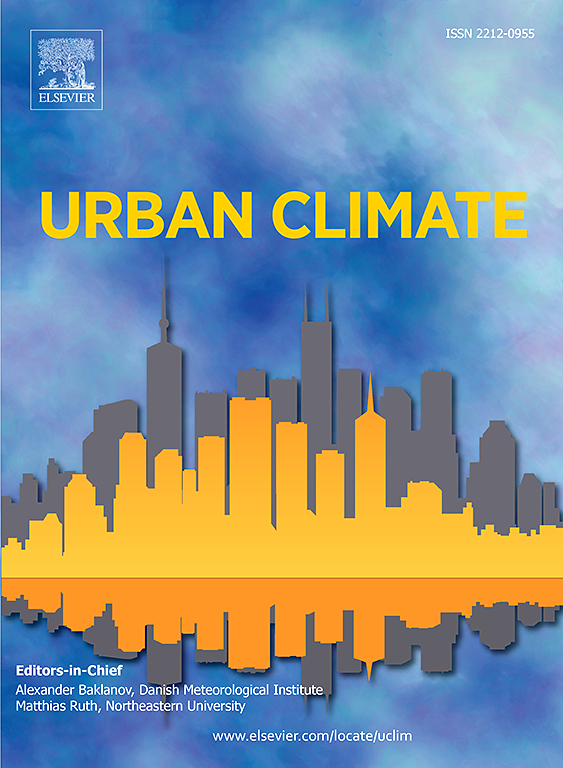Quantifying the cooling effects of blue-green spaces across urban landscapes: A case study of Kathmandu Valley, Nepal
IF 6
2区 工程技术
Q1 ENVIRONMENTAL SCIENCES
引用次数: 0
Abstract
Mitigating extreme heat is crucial for enhancing the livability and sustainability of urban centers in the face of rising temperatures. A sound understanding of temperature variation is necessary to effectively design heat mitigation strategies. In this study, we develop a framework to quantify the cooling effects of blue-green spaces, such as urban forests, parks, and ponds, through the integration of remote sensing and geo-spatial modeling. We then employ the framework across urbanized, transitional, and vegetation-dominated zones in the Kathmandu Valley, Nepal. Across the valley, our results reveal distinct cooling signatures for each type of natural entity, with urban forests exhibiting the greatest cooling potential (up to 1.2 °C reduction), followed by urban parks (0.9 °C) and ponds (0.85 °C). This hierarchical cooling effect can be attributed to the complex interactions between these features and urban heat transfer processes: forests provide more effective barriers against lateral heat movement through their dense canopy structure and multiple vegetation layers, while also maximizing evapotranspiration cooling; parks offer varying degrees of cooling based on their vegetation density and composition; and ponds, while effective through evaporative cooling, are more susceptible to heat absorption from surrounding urban surfaces. Notably, the cooling efficiency of these blue-green spaces is significantly influenced by their size and the surrounding urban context, with the greatest cooling benefits observed in vegetation-dominated zones. However, in highly urbanized areas, the cooling potential of these blue-green spaces is diminished, underscoring the need for context-specific heat mitigation strategies. Our findings highlight the importance of strategically integrating natural entities' size and location into urban planning zoning, plans, and policies to maximize their cooling benefits and offer valuable insights for urban planners worldwide as they strive to enhance resilience. Future research should focus on developing cost-effective implementation strategies and quantifying additional co-benefits of blue-green infrastructure beyond temperature reduction.
城市景观中蓝绿空间的降温效果量化:以尼泊尔加德满都谷地为例
在气温上升的情况下,缓解极端高温对于提高城市中心的宜居性和可持续性至关重要。对温度变化的充分了解对于有效地设计减热策略是必要的。在本研究中,我们开发了一个框架,通过遥感和地理空间建模的整合来量化城市森林、公园和池塘等蓝绿空间的降温效应。然后,我们将该框架应用于尼泊尔加德满都谷地的城市化、过渡性和植被为主的地区。在整个山谷中,我们的研究结果揭示了每种类型的自然实体的不同冷却特征,城市森林表现出最大的冷却潜力(高达1.2°C),其次是城市公园(0.9°C)和池塘(0.85°C)。这种分层冷却效应可归因于这些特征与城市传热过程之间的复杂相互作用:森林通过其茂密的冠层结构和多植被层提供了更有效的屏障,阻止横向热运动,同时也最大化了蒸散发冷却;公园根据其植被密度和组成提供不同程度的降温;池塘虽然通过蒸发冷却有效,但更容易受到周围城市表面热量吸收的影响。值得注意的是,这些蓝绿空间的冷却效率受到其大小和周围城市文脉的显著影响,在植被为主的区域观察到最大的冷却效益。然而,在高度城市化的地区,这些蓝绿空间的冷却潜力被削弱了,这强调了针对特定环境的热缓解策略的必要性。我们的研究结果强调了将自然实体的规模和位置战略性地整合到城市规划分区、计划和政策中的重要性,以最大限度地提高其冷却效益,并为全球城市规划者提供有价值的见解,因为他们正在努力提高弹性。未来的研究应侧重于制定具有成本效益的实施策略,并量化蓝绿基础设施在降低温度之外的额外协同效益。
本文章由计算机程序翻译,如有差异,请以英文原文为准。
求助全文
约1分钟内获得全文
求助全文
来源期刊

Urban Climate
Social Sciences-Urban Studies
CiteScore
9.70
自引率
9.40%
发文量
286
期刊介绍:
Urban Climate serves the scientific and decision making communities with the publication of research on theory, science and applications relevant to understanding urban climatic conditions and change in relation to their geography and to demographic, socioeconomic, institutional, technological and environmental dynamics and global change. Targeted towards both disciplinary and interdisciplinary audiences, this journal publishes original research papers, comprehensive review articles, book reviews, and short communications on topics including, but not limited to, the following:
Urban meteorology and climate[...]
Urban environmental pollution[...]
Adaptation to global change[...]
Urban economic and social issues[...]
Research Approaches[...]
 求助内容:
求助内容: 应助结果提醒方式:
应助结果提醒方式:


